What is the first word that comes to your mind when I say “nature“? Serene? Peaceful? Green?
Green is the second most abundant color found in nature, after blue. The color green presents itself in various shades and hues, often in combination with other colors.
Nature has beautiful ways of maintaining its ecological balance, and green insects and bugs are one example. Their bodies’ hue and shade help them evade predators by camouflaging with the green leaves and trees.
Today, we have a comprehensive list of 40 different bugs and beetles found in nature. Any list will probably not be enough to encompass the enormous number of green bugs and insects in this world.
So, let’s dive into the glorious world of green bugs and beetles!
40 Varieties of Green Bugs and Beetles
1. Common Green lacewings
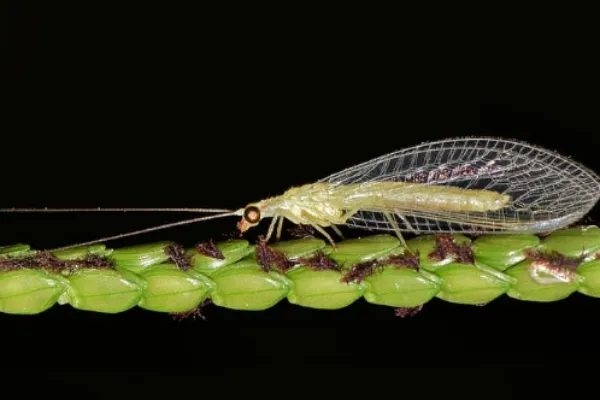
| Scientific Name | Chrysoperla carnea |
| Size | 12-20 mm |
| Location | Europe |
| Habitat | Warmer Elevations |
Chrysoperla carnea is commonly known as the green lacewing, for its striking green coloration, which gives it a distinctive appearance.
Lacewings have pale green wings, threadlike antennae, and glossy golden compound eyes.
Their beautiful green and golden coloration makes them stand out among other insects.
These green hues help the lacewings blend with fresh green leaves and escape their predators.
Green lacewing larvae are known for their active role as biological control agents against a wide range of pests.
By being used for pest management, they have helped reduce the need for chemical pesticides
Their sensitivity towards green allows them to spot and target pest-infested plants.
2. European mantis
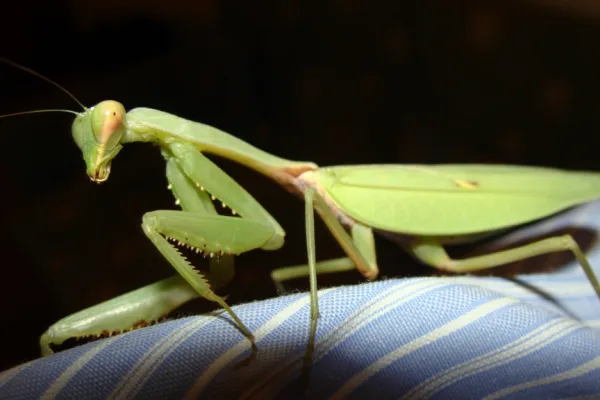
| Scientific Name | Mantis religiosa |
| Size | 6-9 cm |
| Location | Europe, Asia, North America, and Africa |
| Habitat | Found in a variety of areas but is mostly seen in warmer regions at tropical or sub-tropical latitudes |
The European mantis showcases a beautiful green coloration that varies from shades of yellow to brown and green.
This coloration serves a crucial purpose in camouflage, allowing the mantis to blend seamlessly with its environment, whether it’s hiding among fresh green grass or dried-up brown vegetation.
They get their common name “praying mantis” for the distinctive posture they hold their legs to in a manner resembling a praying attitude.
European mantises also exhibit sexual dimorphism, with females typically larger and heavier than males.
They are also known to showcase cannibalistic tendencies during mating. The females tend to feed on the males in order to fulfill their nutritional requirements.
3. Tomato hornworm

| Scientific Name | Manduca quinquemaculata |
| Size | 10 cm |
| Location | North America and Australia |
| Habitat | Places with an abundance of tomato farm |
Tomato hornworm displays a distinct green coloration that helps in its camouflage among the foliage of host plants.
The green hue allows it to blend seamlessly with the leaves of tomato plants and other Solanaceae family plants.
Tomato hornworm is considered a major pest in tomato gardens and agricultural fields.
The dark, pointed projection or “horn” on its rear end gives tomato hornworm its name.
4. Green stink bug
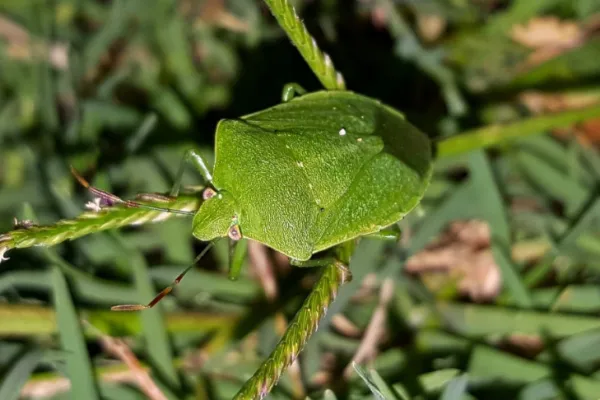
| Scientific Name | Chinavia hilaris |
| Size | 13-18 mm |
| Location | North America and New England |
| Habitat | Orchards, gardens, woodlands, and crop fields |
The green stink bug, also known as the green soldier bug, showcases a striking bright green color that serves as a form of camouflage.
The green stink bug has a distinctive shield-shaped body with an elongated, oval form.
Along with the bright green color, the green stink bug is often adorned with narrow yellow, orange, or reddish edges.
Like other stink bugs, both adults and nymphs of the green stink bug possess large stink glands on the underside of their thorax.
These stink glands get activated and release foul-smelling liquid when disturbed.
5. Great Green Bush crickets

| Scientific Name | Tettigonia viridissima |
| Size | 28-42 mm |
| Location | Europe and North Africa |
| Habitat | Meadows, grasslands, prairies, and gardens |
The great green bush cricket is named for its striking and vibrant green coloration.
The majority of individuals in this species are completely green, creating effective camouflage amidst meadows, grasslands, and gardens where they are commonly found.
However, some individuals may exhibit yellowish hues or have yellow legs.
Great green bush crickets have exceptionally long and thin antennae, almost 3x its length.
They are mostly nocturnal and are found singing during those times.
Though they can bite when attacked, great green bush crickets are usually known to be calm and not particularly aggressive.
6. Green June beetle
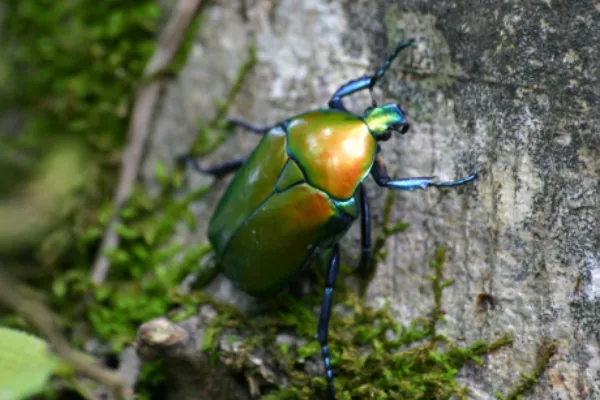
| Scientific Name | Cotinis nitida |
| Size | 15-22 mm |
| Location | The United States and Canada |
| Habitat | Woodlands, agricultural areas, and lawns |
Green June Beetle is known for its metallic green color. Its wings display a dull, metallic green hue, while its sides are adorned with golden hues.
The head, legs, and underside of the beetle are bright, glossy green, which sets them apart from the others.
In its larval stage, it has a white body with a brownish-black head and brown spiracles along the sides.
7. Southern green stink bug

| Scientific Name | Nezara viridula |
| Size | 12.1-13.1 mm |
| Location | America, Asia, Africa, Australia, and Europe |
| Habitat | Tropical and Subtropical areas |
The southern green stink bug boasts a vibrant and distinct green coloration on its body.
Its green hue and distinct shield-shaped body make it stand out from the other species.
It is considered a pest with a particular preference for leguminous plants like beans and soybeans.
Interestingly, they have the ability to undergo reproductive diapause and change their body coloration from green to brown or russet during winter.
8. Snowy tree cricket
| Scientific Name | Oecanthus fultoni |
| Size | 15-18 mm |
| Location | The United States |
| Habitat | Shrubs, vines, fruit trees, and trees |
Snowy tree cricket’s entire body, including its wings, exhibits a translucent light green hue, making it easily recognizable.
One thing that sets it apart is its ability to estimate the temperature.
The rate of its chirping is closely linked to the temperature, allowing listeners to estimate the temperature by counting the number of chirps in a set period. Hence called the “thermometer cricket.”
Though known to cause minimal damage when feeding, female crickets lay eggs by drilling a hole into a twig’s cambium, and the adults create holes in ripe fruits, which can lead to fruit rot.
9. Khonia bladder hopper
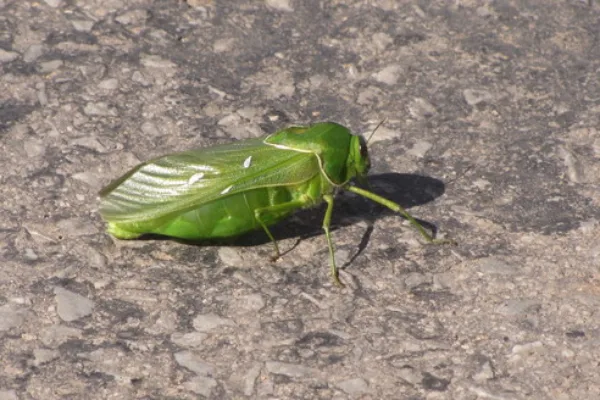
| Scientific Name | Pneumora inanis |
| Size | 11.5-107 mm |
| Location | Eastern Cape and KwaZulu-Natal in South Africa |
| Habitat | Coastal regions |
Pneumoridae is a distinctive family of short-horned grasshoppers, commonly known as bladder grasshoppers. They exhibit great levels of sexual dimorphism.
Males are typically smaller, have an inflated abdomen for sound production, and feature large ocelli and a prominently crested pronotum.
In contrast, females are larger, lack an inflated abdomen, and possess reduced elytra and wings.
Khonia bladder hopper’s inflated, bladder-like abdomen allows them to produce loud, rasping calls that can be detected by individuals from distances of up to 2 kilometers.
10. Glorious beetle
| Scientific Name | Chrysina gloriosa |
| Size | 20-30 mm |
| Location | Southern United States and Northern Mexico |
| Habitat | Abundant in juniper forest |
Glorious beetle is characterized by their striking bright green coloration.
Their elytra, or hardened wing covers, feature remarkable silver stripes that shimmer.
Though rare, species with red and purple have also been documented.
The shimmer on their wings results from the cholesteric liquid crystal organization of chitin molecules in the beetle’s exoskeleton which when viewed at an angle reflects green and silver colors.
Glorious beetles primarily feed on juniper leaves while the larvae sustain themselves by consuming decaying wood from Arizona sycamore trees.
11. Tailed green jay
| Scientific Name | Graphium agamemnon |
| Size | |
| Location | India, China, Taiwan, Japan, and Australia |
| Habitat | Places with heavy rainfall, gardens, and these days urban areas due to food availability |
The tailed green jay is known for its vibrant green coloration.
This dazzling green hue, combined with silver stripes on its elytra, makes them extremely visually appealing.
Like the Glorious Beetle, the color of its wings is not a result of pigments but rather the presence of the cholesteric liquid crystal in its exoskeleton.
When viewed at a certain angle, these exhibit a shimmery green and silver color.
Tailed jays are known for their active and restless flight. They flutter their wings continuously, even while feeding on flowers.
12. Hickory horned devils
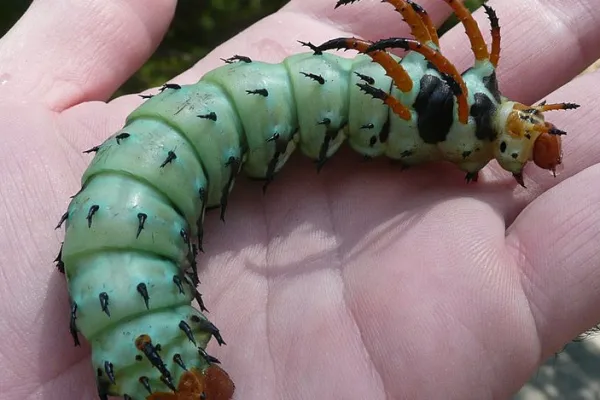
| Scientific Name | Citheronia regalis |
| Size | 15 cm |
| Location | Southern United States |
| Habitat | Deciduous forest areas |
The hickory horned devil holds the title of being the largest moth by mass in regions north of Mexico.
Their size when combined with their distinct appearance makes them stand out.
In its fifth and final instar, the larvae become bright green with large, black-tipped red horns, making them majestic creatures.
Their beautiful black body and red horns make them stand out in their surrounding.
Something that sets them apart is that instead of spinning a cocoon, the regal moth burrows into the ground to create an earthen chamber for pupation.
13. Japanese beetle
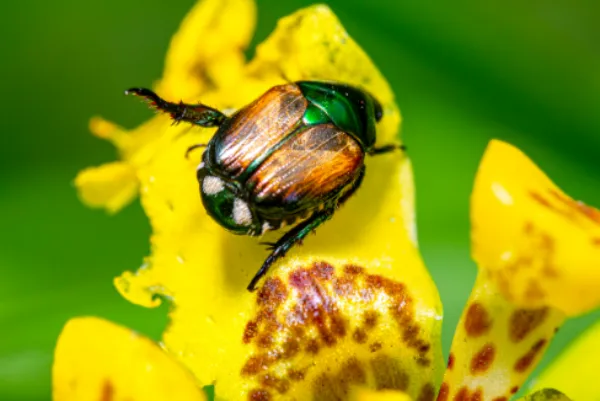
| Scientific Name | Popillia japonica |
| Size | 15 mm |
| Location | Japan, Europe, and North America |
| Habitat | Wide range of area – From wetlands to gardens |
Japanese beetle boasts a brown/copper-colored elytra which sets them apart.
Along with the brownish copper elytra, they exhibit green coloring in their thorax and head.
This contrast gives them a distinctive and eye-catching appearance.
Japanese beetles are vivacious pests, posing a threat to approximately 300 plant species.
While not particularly destructive in Japan, thanks to the natural predators that keep their population in check, Japanese beetles are considered invasive in North America and parts of Europe.
14. Imported cabbageworm
| Scientific Name | Pieris rapae |
| Size | 3.5 cm |
| Location | Europe, Asia, North Africa, and North America |
| Habitat | Open areas with vegetation |
Imported cabbageworm’s green hue is quite distinct and is a result of feeding on crucifer crops like cabbage, kale, and broccoli.
This feeding behavior of these caterpillars makes them a pest in areas where they are found.
Imported cabbage worms have a preference for green leaves when choosing plants to lay their eggs.
These caterpillars are highly dependent on temperature, exhibiting different growth rates at various temperature ranges.
15. Parsley worm

| Scientific Name | Papilio polyxenes |
| Size | 50.8 mm |
| Location | North America |
| Habitat | Open areas like fields, parks, marshes, and deserts |
Understandably so, they are named “Parsley worms” as they extensively feed on the Parsley plant.
Parsley worms are mostly black and white but as they mature, they turn green with black bands running across their body containing yellow spots.
They have an orange “forked gland” called the osmeterium. This structure looks like a snake’s tongue and emits a foul smell, acting as a defense mechanism against predators.
Along with osmeterium, their distinct visual appearance makes them look dangerous and unpalatable to predators.
16. Dead-nettle leaf beetle
| Scientific Name | Chrysolina fastuosa |
| Size | 5.1-6.9 mm |
| Location | Europe, Caucasus, and Northern Turkey |
| Habitat | Riverbanks, woodlands, ditches, and willows |
Dead-nettle leaf beetles have a distinct gold shine that seamlessly transitions into a vivid green or violet-blue longitudinal stripe.
They are herbivores primarily seen feeding on plants belonging to the Lamiaceae family.
This unique gold and green coloration is their way to evade predators by camouflaging within their surroundings.
17. Green rose chafer

| Scientific Name | Cetonia aurata |
| Size | 20 mm |
| Location | Europe, the United Kingdom, and Asia |
| Habitat | Woodland and grasslands |
Green rose chafer has a very distinct green metallic hue which is not a result of pigment but rather a result of the arrangement of its scales.
This beetle has a V-shaped scutellum (small area between its wing cases) which sometimes displays irregular white lines and marks, adding to its unique appearance.
While the primary color of the rose chafer is green, it can also exhibit other colors such as bronze, copper, violet, blue/black, or grey.
Green rose chafer flies with its wing cases down, creating a distinctive appearance in flight.
18. Oak splendor beetle
| Scientific Name | Agrilus biguttatus |
| Size | 8-13 mm |
| Location | Europe, North Africa, and Siberia |
| Habitat | Areas populated with oak trees |
Oak splendor beetle has a vibrant green body with a few hints of black and yellow markings.
The shiny green exoskeleton gives the beetle a jewel-like appearance, hence often referred to as a jewel beetle.
They have a pair of white spots on the inner edges of their elytra giving them an additional aesthetic appearance.
Oak splendor beetle’s larvae are creamy white and can grow up to 43 mm in length.
19. Six-spotted green tiger beetle

| Scientific Name | Cicindela sexguttata |
| Size | 12-14 mm |
| Location | North America |
| Habitat | Deciduous forest |
The six-spotted green tiger beetle vibrant metallic-green to metallic-green Bugs hue covers its elytra.
As the name suggests, the six-spotted green tiger has a presence of six small white spots on its elytra making it stand out even more in its surroundings.
While the name implies six spots, some individuals may exhibit more, fewer, or even no spots due to genetic mutations.
The six-spotted tiger beetle has a relatively long lifespan, with some individuals living up to 3 years.
20. Pale green assassin bug

| Scientific Name | Zelus luridus |
| Size | 12.5-18 mm |
| Location | Eastern United States |
| Habitat | Vegetated areas |
The pale green assassin bug has a pale green coloration throughout its body that gives the bug its name.
This coloration helps them hide amongst the leaves and vegetation and aids in hunting their prey.
While the base color of the pale green assassin bug is pale green, the markings on its back can range from dark brown or red to bright yellow.
It uses an ambush strategy to hunt its prey using a sticky material produced by a gland on the bug’s leg.
While it poses no significant threat to humans, it is advised to stay away from them in the wild as mishandling them can result in a painful bite.
21. Texas striped sweat bee
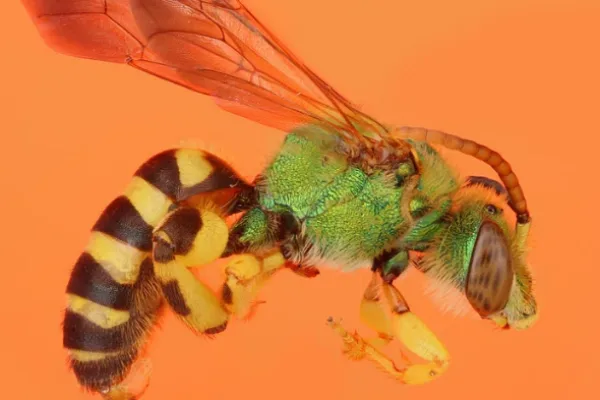
| Scientific Name | Agapostemon texanus |
| Size | 9-11 mm |
| Location | North America |
| Habitat | Loamy soil with cracks for their hiding |
The Texas striped sweat bee is known for its metallic green head and thorax.
The sexes of this species exhibit a low level of sexual dimorphism by exhibiting different hues of green and blue on their body.
Male bees are characterized by black and yellow bands on their metasoma, while females are generally a solid color.
While mostly green, some individuals have color variations.
Female Texas striped sweat bees actively search for suitable nesting sites close to the ground.
22. Fig-eater beetle
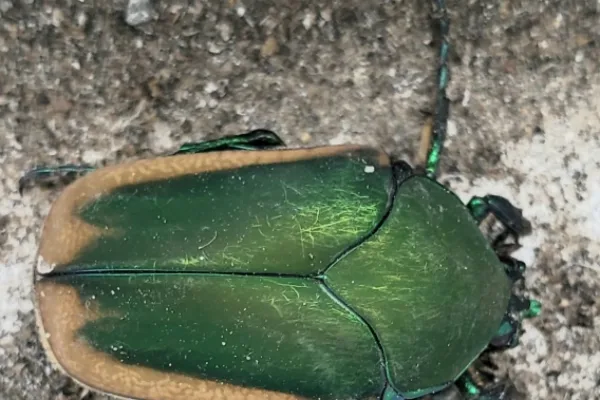
| Scientific Name | Cotinis mutabilis |
| Size | 3.5 cm |
| Location | Southwestern United States and Mexico |
| Habitat | Different types of vegetation and urban areas |
The top side of the fig-eater beetle is semi-glossy green, while the underside and legs exhibit a bright green hue.
Fig-eater beetles are primarily attracted to sweet foods, including the leaves, flowers, and saps of certain plants, as well as ripe or overripe fruit.
They roll onto their backs and use the stiff, dark hairs on their backs to balance themselves as they propel themselves upside down to find food, earning them the nickname ‘crawly backs.
23. Vine hawk-moth
| Scientific Name | Hippotion celerio |
| Size | 8 cm |
| Location | Africa, Asia, Europe, and Australia |
| Habitat | Tropical climate |
The adult vine hawk-moth exhibits a striking combination of green and ochre colors creating a beautiful visual and helping them blend seamlessly with their environment.
It has silvery white dots and streaks on its wings creating a striking appearance against the contrasting green and ochre coloration.
The hindwings are adorned with shades of red on the lower side and pinkish tones in other parts.
The larvae of vine hawk-moth can display a variety of colors ranging from green, yellowish green, or even brown.
24. Green leafhopper
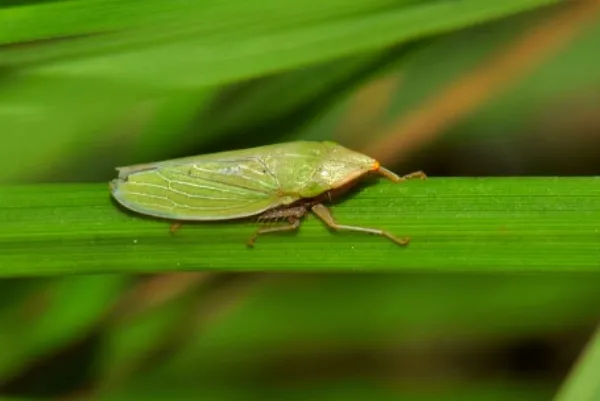
| Scientific Name | Cicadella viridis |
| Size | 5.7-9 mm |
| Location | Europe and parts of Asia |
| Habitat | Grassy areas, marshy lands, wet meadows, and swampy habitats |
The pronotum and scutellum of green leafhoppers are green and yellow.
The forewings display a turquoise green hue in females and a blue or dark bluish shade in males, clearly showcasing sexual dimorphism.
While they are mostly found in wetlands and swampy areas, they can also be found in dry regions making them extremely adaptable.
These leafhoppers are polyphagous, meaning they feed on the sap of various herbaceous plants making them a vital part of the food cycle.
25. Green peach aphid
| Scientific Name | Myzus persicae |
| Size | 1.8-2.1 mm |
| Location | Worldwide, with Asia as its native |
| Habitat | Extreme temperature |
The green peach aphid is characterized by its vibrant green color.
As the name suggests, green peach aphids are a pest to peach trees leading to decreased growth, shriveled leaves, and damage to various plant tissues.
Green peach aphids act as vectors for various plant viruses like cucumber mosaic virus, potato virus Y, and tobacco etch virus.
These aphids are polyphagous and feed on the sap of various herbaceous plants.
They are highly adaptable and can thrive in various environments.
26. Common green bottle fly
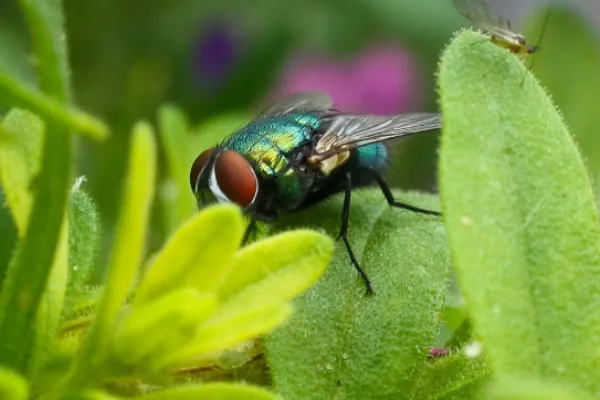
| Scientific Name | Lucilia sericata |
| Size | 10-14 mm |
| Location | Asia, Europe, Africa, and Australia |
| Habitat | Tropical, arid, and coastal regions |
The common green bottle fly is known for its distinctive metallic blue-green or golden coloration.
Another distinct feature of the common green bottle fly is the presence of three bristles on the dorsal mesothorax, situated in the middle of its back.
Call them the CID of the insects, as forensic entomologists rely on the developmental stage of these flies on a corpse to determine the approximate time of death.
Along with helping solve crimes, larvae of this species have been used in maggot therapy to heal wounds and promote tissue regeneration.
27. Green darner
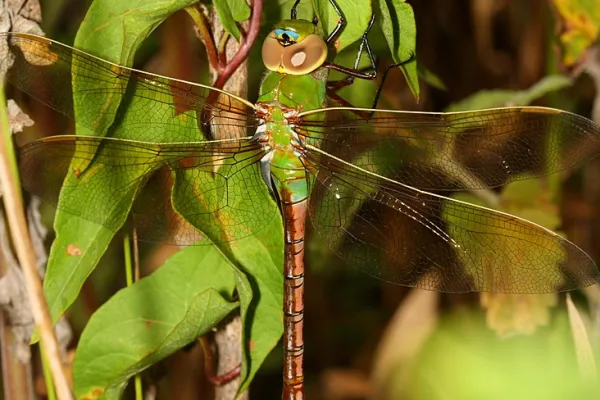
| Scientific Name | Anax junius |
| Size | 76-80 mm |
| Location | North America |
| Habitat | Lakes, ponds, and rivers |
Both male and female green darners have an unmarked green thorax, making them instantly recognizable among dragonfly species.
Their green coloration aids in camouflage as they hunt for prey in a range of habitats.
These dragonflies are known for their remarkable migratory behavior.
They undertake extensive migrations, with some individuals traveling as far as 140 kilometers in a single day.
28. Green tiger beetle

| Scientific Name | Cicindela campestris |
| Size | 12-15 mm |
| Location | Europe and some parts of Asia |
| Habitat | Dry and hot regions |
The green tiger beetle has its elytra and thorax in shades of green.
In bright sunlight, these green surfaces display a subtle shine, enhancing their visual appearance.
The green tiger beetle is known for its affinity towards sunlight, which may have a role in its bright green coloration.
They have long legs which makes them adept runners, capable of reaching speeds of up to 60 centimeters per second.
29. Long-winged conehead
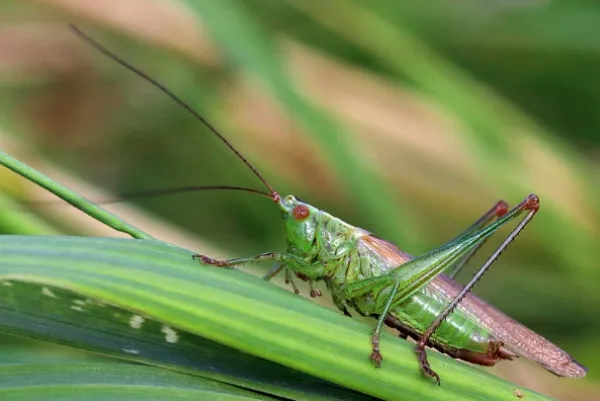
| Scientific Name | Conocephalus fuscus |
| Size | 16-22 mm |
| Location | Europe and temperate Asia |
| Habitat | Grassy meadows, woodlands, marshes, and vegetation |
The long-winged conehead had a bright grass-green body with a brown dorsal stripe down its back, giving it a striking appearance.
Originally native to the British Isles, there has been a significant range expansion seen by long-winged coneheads due to global climate change.
Male long-winged coneheads produce a unique “song” by rubbing their forewings together.
The song consists of distinctive syllables and can be heard from a considerable distance.
Despite, the potential risk of attracting predators, males continue to make the sound to attract the females.
30. Emerald ash borer
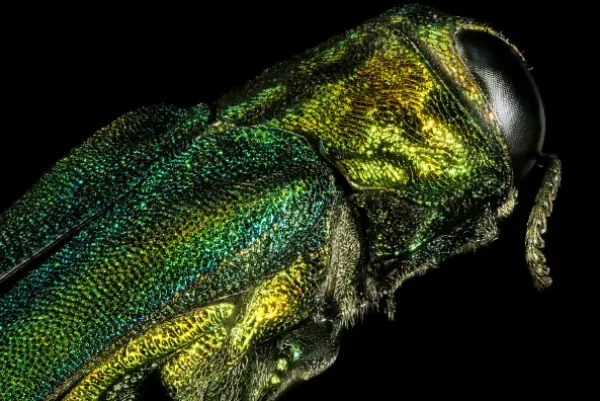
| Scientific Name | Agrilus planipennis |
| Size | 8.5 mm |
| Location | Asia and North America |
| Habitat | Fertile and well-drained soil and places highly populated with ash trees |
The emerald ash borers are typically bright metallic green with elytra that displays a darker green or even copper hue.
While emerald ash borers are native to northeastern Asia and are not known to cause damage there.
Outside its native, that is in North America and Europe they are considered a highly destructive invasive species.
The larvae of Emerald ash borer create long, zig-zag paths as they feed, disrupting the tree’s ability to transport nutrients and water, eventually leading to the tree’s death.
Several treatments have been undertaken to keep the population of these beetles under control.
31. Luna moth

| Scientific Name | Actias luna |
| Size | 114-178 mm |
| Location | North America and some parts of Europe |
| Habitat | Deciduous woodlands |
These magnificent moths are ethereal. Their lime-green wings and white body sets them apart from many other moths.
Luna moths have evolved intriguing defense mechanisms against their predators.
They emit clicking sounds as a warning to potential predators.
Additionally, when threatened, they can regurgitate (bring up) their intestinal contents, which acts as a deterrent to various predators.
Luna moths have captured the mind of many due to their striking green color, and elegant appearance.
These moths are often considered a symbol of beauty, transformation, and the mysterious allure of the nighttime world.
Their short lifespan, typically lasting only 7–10 days adds to their value.
32. Kaisar-i-Hind
| Scientific Name | Teinopalpus imperialis |
| Size | 90-120 mm |
| Location | Along the Himalayas and parts of China |
| Habitat | High-altitude forest areas |
The Kaisar-i-Hind butterfly is renowned for its captivating green shimmer.
This hue is not due to pigments but rather results from a 3D photonic structure in the scales of its wings, giving the butterfly an even more aesthetic appearance.
They display a moderate level of sexual dimorphism. While the males have a bright chrome-yellow patch on each hindwing, the females have a larger dark grey patch on the hindwing.
The Kaisar-i-Hind is a rare and protected butterfly species in India and Nepal. Despite regulations, collectors pay a hefty amount to possess this butterfly.
33. Oleander hawk-moth
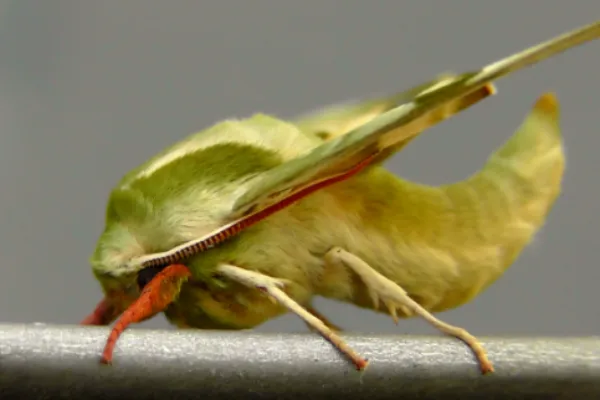
| Scientific Name | Daphnis nerii |
| Size | 7.5-8.5 mm |
| Location | Africa, Asia, and some parts of Europe |
| Habitat | Warm places |
The oleander hawk-moth exhibits a striking green coloration throughout its body.
They are known for their extensive migratory range. During the summer, it migrates to various parts of Europe.
Oleander hawk-moths are extensive eaters of leaves of oleander tree, which is highly toxic but these caterpillars have developed immunity to its toxins.
Their larvae also possess green bodies with black spots that help ward off potential threats in their environment.
34. Silver-green leaf weevil

| Scientific Name | Phyllobius argentatus |
| Size | 3.8-6 mm |
| Location | Europe |
| Habitat | Under loose barks and dead leaves |
Silver-green leaf weevil is easily recognizable due to its vibrant metallic green coloration.
Silver-green leaf weevil possesses a slender and elongate body which when combined with its unique coloration makes it stand out.
They have a large appetite feeding on a wide range of host plants, including those from various plant families such as Salicaceae, Rosaceae, Ulmaceae, Fagaceae, and Betulaceae.
In some parts of Europe, they are considered a pest, particularly in fruit orchards and hazelnut groves.
35. Common green grasshopper
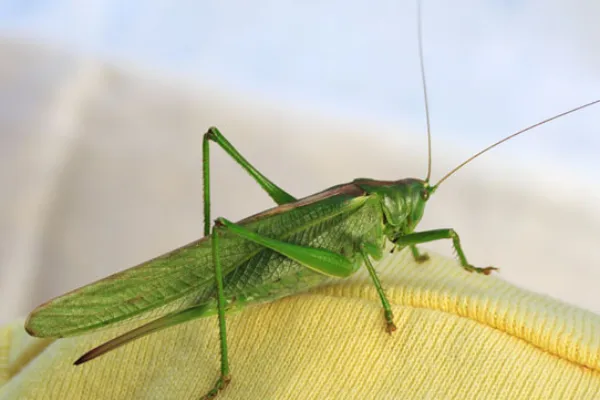
| Scientific Name | Omocestus viridulus |
| Size | 17-20 mm |
| Location | Europe |
| Habitat | Wetlands and moist areas |
The common green grasshopper is known for its vibrant green coloration throughout its body.
Some individuals may exhibit brown coloration on the sides, but green is the predominant color.
Unlike the many other ‘choosy’ bugs this feeds on common and abundant grass species, promoting greater vegetation diversity.
They prefer areas with longer grass aiding them in evading their predators.
Like the Long-winged conehead, the male common green grasshopper produces songs, using its hind legs and wings to attract the females.
36. Angeles striped sweat bee
| Scientific Name | Agapostemon angelicus |
| Size | 10-14 mm |
| Location | North America and some parts of the central USA |
| Habitat | Desert region |
The female Angeles striped sweat bee has a vibrant metallic green coloration throughout its body.
Individuals in this species showcase sexual dimorphism in terms of patterns in their body.
While females are metallic green all over, males have a bright yellow and black banded metasoma.
Their parenting style is unusual as they do not feed their young honey, but instead leave balls of pollen in the nest for the young honey to feed on.
The young bees then consume the pollen as their food source.
37. Buffalo treehopper
| Scientific Name | Stictocephala bisonia |
| Size | 6-8 mm |
| Location | North America and throughout southern Europe |
| Habitat | Tropical forests and sometimes vegetation |
Buffalo treehoppers are known for their bright green coloration, which helps them blend in with their surroundings.
They have a triangular shape making them resemble thorns or twiggy protrusions on plants aiding them to escape their predators.
During the summer months, male buffalo treehoppers attract females by producing a song.
The females here don’t hear these songs as sound waves but rather vibrations from host plants, indirectly attracting them to the males.
While they are generally not considered a threat to the host plants, they can occasionally harm young fruit trees
38. Green banana cockroach
| Scientific Name | Panchlora nivea |
| Size | 12-24 mm |
| Location | Southern United States |
| Habitat | Trees, shrubs, and herbaceous plants |
Who said cockroaches are only brown? These Cuban cockroaches have pale green to yellowish green bodies, with a yellow line running along their sides.
This cockroach species is primarily an outdoor insect and is rarely found indoors.
These green cockroaches are nocturnal and thanks to their non-invasive nature, they are often kept as a pet roach.
If their presence bothers you, it can also be used as food for other pets, particularly reptiles and amphibians!
Interestingly, to mature from nymphs to adults, males take around 144 days and females around 181 days.
39. Broken-backed bug
| Scientific Name | Taylorilygus apicalis |
| Size | 4-5 mm |
| Location | Europe, Australia, and North America |
| Habitat | Vegetation and open land |
Broken-backed bug is known for its light green coloration.
However, it may also appear tan in some cases but the light green hue is a prominent color of this bug.
Their wing tips appear bent downward at a 45-degree angle, resembling a “broken back”, giving them their name.
They lay eggs during the spring season and multiple generations can occur during the season.
Both nymphs and adults can transmit diseases.
40. Green lynx spider

| Scientific Name | Peucetia viridans |
| Size | 12-22 mm |
| Location | Southern and Central America and West Indies islands |
| Habitat | Clumps of prickly pear cactus |
Green lynx spider is known for its striking bright green coloration which helps it blend in with its plant habitat and serves as camouflage while hunting for prey.
The dorsal surface of the abdomen features approximately six Chevron-like marks with centers pointing forward.
These markings, combined with the green and yellow coloration, help differentiate them from other species.
Unlike the other spiders, the green lynx spider does not use a web to catch its prey but instead pounces on its victims in a cat-like manner, giving them the name “lynx.”
Conclusion:
With this, we come to the end of yet another article helping us unravel the mysteries of nature. Tune in to discover more about the world you live in, and we shall see you next time with a new article every day!
Also Read:

Hi everyone, my name is Shawna, and I’ve always been fascinated by the fascinating diversity of flora and fauna that our nature has in it. I am currently studying biotechnology and am particularly interested in animal biotechnology, delving into the intricate processes that define their true nature and uniqueness.
